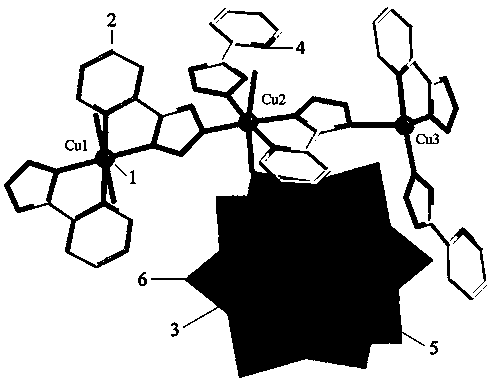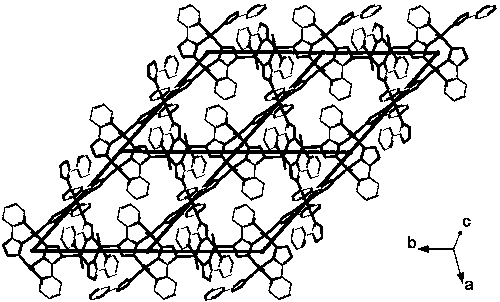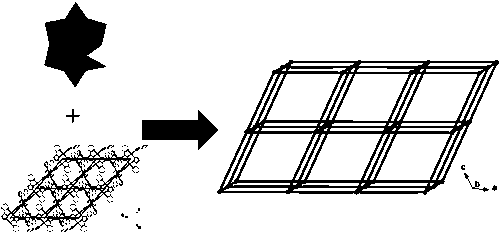POM (polyoxometalate)-based crystal material adopting 3D intercalation structure and preparation method of POM-based crystal material
A technology of crystal materials and layer structures, applied in chemical instruments and methods, hydrogen production, organic compound/hydride/coordination complex catalysts, etc., can solve difficult problems
- Summary
- Abstract
- Description
- Claims
- Application Information
AI Technical Summary
Problems solved by technology
Method used
Image
Examples
specific Embodiment approach 1
[0025] Specific implementation mode 1: This implementation mode is a polyacid-based crystal material with a three-dimensional intercalation structure that has the effect of photocatalytically decomposing water to produce hydrogen. The chemical formula is [Cu Ⅱ 5 (2-ptza) 6 (H 2 O) 4 (GeW 12 o 40 )]·4H 2 O, where 2-ptza is 5-(2-pyridine)-tetrazolium; the crystal system is triclinic; the space group is P-1; the unit cell parameters are a=104.873(5), b=111.480(5) , g=105.681(5), a=12.203(5) Å, b=13.495(5) Å, c=14.262(5) Å, z=1.
[0026] The [Cu Ⅱ 5 (2-ptza) 6 (H 2 O) 4 (GeW 12 o 40 )]·4H 2 The valence of Cu in O is +2.
[0027] Compared with the prior art, this embodiment has the following characteristics:
[0028]The present invention adopts a simple one-step hydrothermal synthesis method, and for the first time successfully prepares a three-dimensional intercalation compound with the effect of photocatalytic decomposition of water to produce hydrogen by using 5-...
specific Embodiment approach 2
[0029] Embodiment 2: This embodiment is a method for preparing a polyacid-based metal-organic framework crystal material with nanopores assembled by flexible ligands, which is completed in the following steps:
[0030] 1. Prepare a reaction solution with a pH value of 3.5: Dissolve germanium tungstic acid, copper nitrate, and 5-(2-pyridine)-tetrazolium organic ligands into deionized water to obtain a reaction solution; adjust the pH value of the reaction solution to 3.5, to obtain a pH value of 3.5 reaction solution;
[0031] The molar ratio of germanium tungstic acid to metal copper salt described in step 1 is: 0.1: (0.2-1);
[0032] The molar ratio of the germanium tungstic acid described in step 1 to the tetrazolium-containing organic ligand is: 0.1: (0.2-0.5);
[0033] The volume ratio of the amount of germanium tungstic acid described in step 1 to distilled water is: 0.1mmol: (20ml~35ml);
[0034] 2. Add the reaction solution with a pH value of 3.5 into a polytetrafluor...
specific Embodiment approach 3
[0038] Embodiment 3: The difference between this embodiment and Embodiment 2 is that the metal copper salt described in step 1 is copper sulfate, copper nitrate or copper chloride. Others are the same as in the second embodiment.
PUM
 Login to View More
Login to View More Abstract
Description
Claims
Application Information
 Login to View More
Login to View More - R&D
- Intellectual Property
- Life Sciences
- Materials
- Tech Scout
- Unparalleled Data Quality
- Higher Quality Content
- 60% Fewer Hallucinations
Browse by: Latest US Patents, China's latest patents, Technical Efficacy Thesaurus, Application Domain, Technology Topic, Popular Technical Reports.
© 2025 PatSnap. All rights reserved.Legal|Privacy policy|Modern Slavery Act Transparency Statement|Sitemap|About US| Contact US: help@patsnap.com



